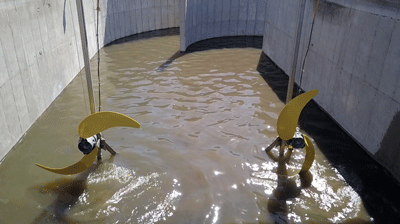
Globe, Arizona, is a small-town jewel located about 90 minutes east of Phoenix. Founded as a mining town in 1876, the city is located in the heart of Arizona’s Tonto National Forest and surrounded by spectacular mountain vistas. Today, Globe remains an important copper mining center and ranching community.
Challenge
The existing aeration system at the Pinal Creek Wastewater Treatment Facility (WWTF) that serves the City of Globe had been in use since the 1980s. By 2019, the aging equipment had compromised flow circulation and reduced treatment capabilities and energy efficiency.
“We had an old jet header system but we lost a few of the jet headers so that handicapped the system and the circulation,” said Frank Baroldy, retired facility manager.
Engineers designed a new aeration system that consists of new fixed fine bubble diffuser grids, new slow-speed adaptive submersible mixers, new positive displacement blowers and process optimization through a control system.
Solution
As part of the upgrades, the city sought to replace its jet aerators to improve aeration and energy efficiency. The complete solution includes an oxidation ditch that uses dedicated adaptive mixers and aeration to provide flexibility and energy efficiencies that traditional mechanical aeration/mixing systems cannot match.
This strategy provides air from the bottom using full floor aeration coverage. The fine bubble diffusers are installed as grids along designated portions within the oxidation ditch, allowing the respective oxidation ditch to operate with simultaneous nitrification and denitrification. With the aid of the adaptive mixers, the channel velocity within the oxidation ditch is kept at a minimum velocity of one foot per second to prevent settling, without adding additional air that would be needed if used to prevent settling.
To save on costs, an existing raceway oxidation ditch built in 1986 was retrofitted to accommodate the treatment solution and two adaptive mixers. When the ditch was emptied for the new system installation, crews discovered six feet of sludge at the bottom, resulting from the prior system’s inability to keep the wastewater contaminants in solution.
The WWTF also installed a process performance optimizer to continuously regulate the oxidation ditch. The system identifies the amount of air going into the treatment process, and in response, the speed of the adaptive mixers adjusts automatically to the correct thrust needed to keep the velocity in the ditch that prevents solids settling.
Since the completion of the retrofit project, the WWTF has realized a savings of more than 50% in operating costs. According to current facility manager Vince Mariscal, the WWTF has seen several benefits from using the adaptive mixers, including an increase in energy efficiency and savings, less time spent maintaining the mixers and improved quality of effluent.
“In regards to energy savings, we’ve seen 50% in reduction of energy use,” said Mariscal.

